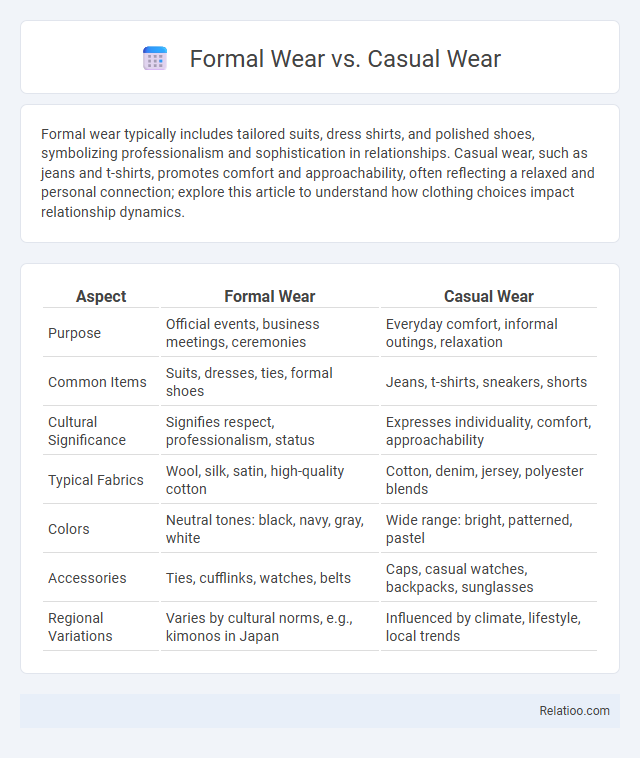Formal wear typically includes tailored suits, dress shirts, and polished shoes, symbolizing professionalism and sophistication in relationships. Casual wear, such as jeans and t-shirts, promotes comfort and approachability, often reflecting a relaxed and personal connection; explore this article to understand how clothing choices impact relationship dynamics.
Table of Comparison
| Aspect | Formal Wear | Casual Wear |
|---|---|---|
| Purpose | Official events, business meetings, ceremonies | Everyday comfort, informal outings, relaxation |
| Common Items | Suits, dresses, ties, formal shoes | Jeans, t-shirts, sneakers, shorts |
| Cultural Significance | Signifies respect, professionalism, status | Expresses individuality, comfort, approachability |
| Typical Fabrics | Wool, silk, satin, high-quality cotton | Cotton, denim, jersey, polyester blends |
| Colors | Neutral tones: black, navy, gray, white | Wide range: bright, patterned, pastel |
| Accessories | Ties, cufflinks, watches, belts | Caps, casual watches, backpacks, sunglasses |
| Regional Variations | Varies by cultural norms, e.g., kimonos in Japan | Influenced by climate, lifestyle, local trends |
Introduction to Formal and Casual Wear
Formal wear typically includes suits, tuxedos, and evening gowns designed for professional or ceremonial occasions, emphasizing elegance and structure. Casual wear consists of comfortable, relaxed clothing like jeans, t-shirts, and sneakers, intended for everyday use and informal settings. Understanding your dress code ensures you select the appropriate outfit, balancing style with the expectations of the event.
Defining Formal Wear: Key Characteristics
Formal wear is characterized by tailored fabrics, structured designs, and classic styles such as tuxedos, evening gowns, and dress shoes, emphasizing sophistication and elegance. Key features include high-quality materials like silk, satin, or fine wool, with details such as cufflinks, waistcoats, and polished finishes. This attire is typically required for occasions with strict dress codes such as black-tie events, weddings, and official ceremonies.
Understanding Casual Wear: Features and Styles
Casual wear emphasizes comfort and practicality, featuring relaxed fits, breathable fabrics like cotton and denim, and versatile pieces such as t-shirts, jeans, and sneakers. Unlike formal wear, which includes structured suits and dress shirts, casual attire allows for personal expression and adaptability to everyday activities. Understanding casual wear involves recognizing its role in dress codes that prioritize informal settings while maintaining a polished, effortless appearance.
Historical Evolution of Dress Codes
Dress codes have evolved significantly from rigid, status-indicating formal wear in ancient societies to the more relaxed casual wear prevalent today, reflecting social changes and cultural shifts. Formal wear, once defined by strict rules and elaborate designs in aristocratic and ceremonial contexts, contrasts with the rise of casual attire that emerged during the 20th century as workplaces and social norms embraced comfort and practicality. Your understanding of these distinctions highlights how dress codes continue to adapt, balancing tradition with contemporary lifestyles.
Occasions Suited for Formal Wear
Formal wear is best suited for occasions such as weddings, galas, corporate events, and upscale dinners where elegant and sophisticated attire is expected. Your choice of formal wear should include tailored suits, tuxedos, or evening gowns that align with the event's dress code guidelines. Understanding the distinctions between formal wear, casual wear, and dress codes ensures you are appropriately dressed, enhancing your confidence and presence.
When to Choose Casual Wear
Casual wear is ideal for informal settings such as weekend outings, relaxed office environments, and social gatherings where comfort and personal style take precedence. Unlike formal wear, which is reserved for ceremonies, business meetings, and other occasions requiring a polished appearance, casual attire allows for greater flexibility with denim, t-shirts, and sneakers. Understanding dress codes helps in selecting appropriate casual outfits that balance ease and appropriateness without compromising professionalism or style.
Material and Fabric Differences
Formal wear typically features luxurious fabrics such as silk, satin, wool, and high-quality cotton blends that offer a polished and structured appearance. Casual wear favors breathable, comfortable materials like jersey, denim, linen, and cotton that allow ease of movement and relaxed style. Dress codes dictate appropriate fabric choices by occasion, with formal codes requiring refined textures and finishes, while casual codes permit versatile, durable, and low-maintenance fabrics.
Impact on First Impressions and Professionalism
Formal wear, characterized by tailored suits, dress shirts, and polished shoes, significantly enhances professionalism and conveys authority, making a lasting positive first impression in corporate or ceremonial settings. Casual wear, such as jeans and t-shirts, promotes comfort and approachability but may undermine perceived competence in formal environments, affecting your professional image. Understanding and adhering to the appropriate dress code ensures your attire aligns with the occasion, reinforcing credibility and respect in both social and professional interactions.
Comfort and Functionality Compared
Formal wear typically prioritizes appearance and structure, often incorporating materials like satin, silk, and tailored fabrics that may compromise comfort for style and professionalism. Casual wear emphasizes comfort and versatility with breathable fabrics such as cotton, jersey, and denim, allowing ease of movement and suitability for relaxed settings. Dress codes dictate the balance between formal wear and casual wear, ensuring appropriateness while potentially limiting comfort and functionality depending on the event or workplace standards.
Fashion Trends: Blurring the Line Between Formal and Casual
Fashion trends are increasingly blurring the line between formal wear and casual wear, with designers integrating elements from both styles to create versatile dress codes that adapt to various occasions. Your wardrobe can now include tailored blazers paired with sneakers or sleek loafers matched with relaxed chinos, reflecting the evolving demand for comfort without sacrificing sophistication. This fusion challenges traditional dress codes and encourages personal expression through hybrid outfits that suit both professional environments and social settings.

Infographic: Formal Wear vs Casual Wear
 relatioo.com
relatioo.com